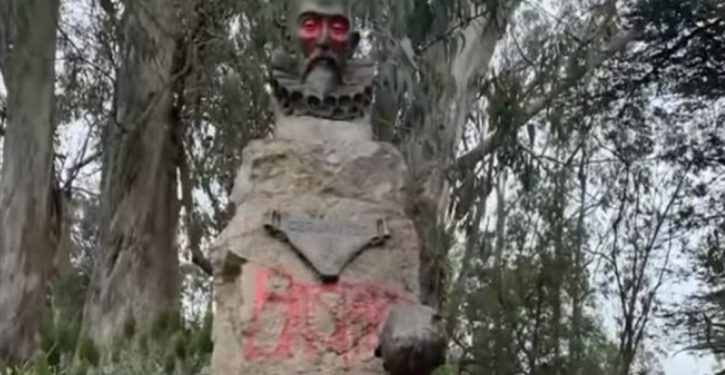
Must Arabs, Turks, and Africans kneel, begging the Europeans to forgive them for their atrocities in the recent past?
In late June, vandals desecrated the monument to novelist Miguel de Cervantes in San Francisco. Thus Cervantes was turned into a “slave owner,” another life subject to cancelation.
Yet it is well known that this great writer and brave hidalgo was a slave of the Algerian corsairs for five years. They seized him on a ship sailing from Naples to Barcelona.
Will this presidential election be the most important in American history?
Cervantes became the property of the cruel Muslim Albanian Dali-Mami, who went by the nickname Lame. The rowers on his ship were white Christian slaves. Being shackled in place, they ate, slept, and defecated right where they sat. Many of them were missing ears, noses or eyes – the result of Dali-Mami’s outbursts of anger. Once, he ordered the hand cut off a guilty rower and beat the whole team with this hand.

In Algeria things were not much better. Slave auctions lasted from 8 a.m. to 2 a.m. Miserable people were forced to run and jump to show their strength and endurance; overseers cut off their hands for every stolen penny, as prescribed by Muslim laws. Executions, mutilations, and torture of slaves were everyday fun for the Algerian Dey. You would see naked people dying in agony under the scorching sun near his house. Wall hooks outside the prison gates were “decorated” with the heads of Christian slaves being pecked up by kites.
Belonging to a noble famous family saved the life of the writer, but fortune was not so favorable to hundreds of thousands of other slaves.
During the four centuries of the Ottoman Empire, the life of white Christians in the coastal cities of Europe was turned into a hell.
The pirates of Hayreddin Barbarossa (Hizir-reis), who was Sultan Suleiman I’s vassal, freely reigned in the “Turkish lake” (the Mediterranean Sea). It is difficult to describe the horror in which the inhabitants of Spanish, Italian and Sicilian villagers lived. Berbers usually came at night when people were sleeping. Breaking into houses, they murdered old people and captured young men and women, girls, and boys, who were valuable commodities at slave markets. As a rule, after a “successful” raid, the whole village or the entire city was burnt.
Women, teenagers and children were destined for sexual pleasure. Paintings of the seventeenth through nineteenth centuries, such as Jean-Leon Gerôme’s “The Slave Market” or Giulio Rosati’s “Inspection of the New Arrivals,” often tell pernicious stories. In one, a wealthy sheikh is depicted examining and touching a European woman standing in front of him. A servant meanwhile carefully measures her while the owner is bargaining briskly over the value of “live goods.”

Masses of white slaves entered the gigantic slave markets of Algeria, Constantinople (Istanbul), and other large cities of the conquered Byzantine Empire. Those marketplaces (“Esir” or “Yesir”) were established by Sultan Mehmed II in the fifteenth century and were located in most towns and cities of the Ottoman Empire. The French sixteenth-century traveler Nicolas de Nicolay described them as gigantic accumulations of naked, submissive, and frightened people, who were mockingly touched, examined, and patted on the stomach, back, sides and buttocks like cattle by visiting merchants and local wealthy townspeople.
According to Ohio State University Professor of History Robert Davis, from the beginning of the sixteenth century to the middle of the eighteenth, up to 1.25 million Europeans were enslaved in North Africa.
The raids and captures of white slaves were well-planned military operations. In 1544 Hayreddin captured the island of Ischia, taking 4,000 prisoners. After that he enslaved about 5,000 inhabitants of Lipari. In 1551 Turgut Reis, yet another “red beard,” enslaved the entire population of the Maltese island of Gozo, about 6,000 people. All of them were sent to Ottoman Tripolitania, or what is now coastal Libya. In 1554 he destroyed the town of Vieste in Italy’s Apulia region. Five thousand of its inhabitants were beheaded in ISIS style (Islam is a religion of peace, isn’t it?), and 6,000 (mostly women and children) were turned into slaves. In the next year he burnt Bastia in northern Corsica and enslaved 6,000 inhabitants. Today you can see the majestic monuments of Turgut Reis and Barbarossa in Istanbul. Why not blow them to hell?
The Aeolian Islands, Amalfi, Massa Lubrense, Cantone and Sorrento, Torre del Greco, the coasts of Tuscany, Piombino — there was practically no place on the coast of Italy where the earth would not be saturated with the blood and tears of victims of the corsairs.
Many coastal regions of Europe were completely depopulated. Not a single European country, even the most remote ones, felt safe. In June 1631 Murat Reis captured Baltimore in Ireland, whereupon all of its inhabitants were taken to North Africa. Men were turned into galley slaves, while women became sex slaves of sheikhs and emirs. For the Berbers, red-haired Celtic girls were an exotic delicacy.
Even Iceland was plundered in a series of raids in July 1627. Since old or sick people had no value in the states of the Barbarian Coast, they were locked in churches and set on fire. One of the few who managed to return from captivity — the priest Olaf Egilsson — later wrote a book about these events.
In 1886 (back then, fortunately, the world didn’t know about political correctness yet), The New York Times described the trafficking of girls and women from the Caucasus, Syria, and Nubia. Caucasian Christian girls were considered especially beautiful — fair-skinned and therefore expensive. They cost up to 500 lire and were often bought as gifts for Ottoman nobles or officials.
For centuries, the Crimean Khanate (vassal of the Ottoman Empire) raided the territory of Russia, the Balkans, and Eastern Europe. This was known in history as “harvesting of the steppe.” On average, the Crimean Tatars took into slavery 10 thousand people per year from these lands. From 1468 to 1694, about 2 million Russians, Ukrainians, and Poles were driven into “jasyr.” The slave trade in Kaffa (now Feodosia) stopped only after the Crimea was conquered by Catherine II in 1783. It was only 250 years ago.
Perhaps it’s time now to erect monuments to these millions of unfortunate people?
And the last, but the most important thing. The Ottomans, Arabs and Berbers renounced slavery not by their own goodwill, but under the guns of American, British, and Dutch frigates. It was one of the most glorious “human rights” victories in the world history.




